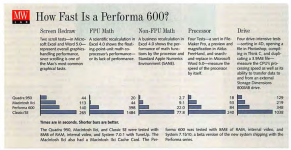That makes sense and also makes it worse.
Backing away from hypotheticals and armchair CEOing for a moment, Ive shared this before and I'll definitely share it again, but I wanted to re-state MacWorld's case for the Performa 600:
On the other hand, just by way of "What it was like to buy a Mac in 1992" - the Performa 600 wasn't the worst possible thing. MacWorld benchmarked and reviewed it in 1992 and the conclusion was basically, half the speed of the IIci, but also half the cost, graphics that don't eat regular RAM, VRAM upgrade to get 16-bit color, CD-ROM drive and a bundled software loadout and keyboard making it a good machine for somebody who was getting started, needed a second computer, or had relatively "basic" needs. (i.e. these things were never
meant for laying out a newspaper or doing photo manipulation on and shouldn't be judged that way.) That review is here:
https://www.vintageapple.org/macworld/pdf/MacWorld_9211_November_1992.pdf
I had a Performa 600 as a kid, and used it alongside a Performa 578 and a Quadra 840av, and it was thoroughly
fine. I don't remember really doing an awful lot with it. I didn't have networking gear, external mass storage, a modem suitable for it, or anything like that, so it mostly sat next to my iMac or one of my other machines and I thought about how cool it would be to have more infrastructure.

The conclusion is basically "it's fine, it's got some neat tricks, CD-ROM is the future, it's not a great performer but it's expandable and relatively inexpensive."
For completeness, here are MacWorld's benchmark/test results:

They're not great, but if you're shopping around, neither is the IIci relative to a Quadra, which is a huge point people miss when discussing the IIvx and the Performa 600. This point often gets missed when discussing low end Macs in general. The next point of comparison upward was, itself, disappointing compared to whatever was at the top of the line. And, that's fine. These systems, are all priced different ways (and in 1992 the Performas were literally
sold a different way, to a different market, sitting next to comparable machines on the PC side of the fence) and perform differently for different markets.
I get that this is a bummer for people who end up with them used and might want to do different things with them, or a common theme here, people whose parents buy a machine for themselves and then share it with the kids who then gain additional interests over what the parents do. I lived all of that too (although I lived in a suburb of Seattle as a kid and early MLA poster, so my Quadra 840av was like $40 in 2000 or 2001 when I got it so, for whatever that's worth.)


